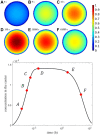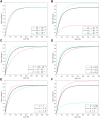Characterization of the Shells in Layer-By-Layer Nanofunctionalized Particles: A Computational Study
- PMID: 35845400
- PMCID: PMC9280187
- DOI: 10.3389/fbioe.2022.888944
Characterization of the Shells in Layer-By-Layer Nanofunctionalized Particles: A Computational Study
Abstract
Drug delivery carriers are considered an encouraging approach for the localized treatment of disease with minimum effect on the surrounding tissue. Particularly, layer-by-layer releasing particles have gained increasing interest for their ability to develop multifunctional systems able to control the release of one or more therapeutical drugs and biomolecules. Although experimental methods can offer the opportunity to establish cause and effect relationships, the data collection can be excessively expensive or/and time-consuming. For a better understanding of the impact of different design conditions on the drug-kinetics and release profile, properly designed mathematical models can be greatly beneficial. In this work, we develop a continuum-scale mathematical model to evaluate the transport and release of a drug from a microparticle based on an inner core covered by a polymeric shell. The present mathematical model includes the dissolution and diffusion of the drug and accounts for a mechanism that takes into consideration the drug biomolecules entrapped into the polymeric shell. We test a sensitivity analysis to evaluate the influence of changing the model conditions on the total system behavior. To prove the effectiveness of this proposed model, we consider the specific application of antibacterial treatment and calibrate the model against the data of the release profile for an antibiotic drug, metronidazole. The results of the numerical simulation show that ∼85% of the drug is released in 230 h, and its release is characterized by two regimes where the drug dissolves, diffuses, and travels the external shell layer at a shorter time, while the drug is released from the shell to the surrounding medium at a longer time. Within the sensitivity analysis, the outer layer diffusivity is more significant than the value of diffusivity in the core, and the increase of the dissolution parameters causes an initial burst release of the drug. Finally, changing the shape of the particle to an ellipse produces an increased percentage of drugs released with an unchanged release time.
Keywords: drug diffusion; drug dissolution; drug release; layer-by-layer; mathematical modeling.
Copyright © 2022 Barchiesi, Wareing, Desmond, Phan, Gentile and Pontrelli.
Conflict of interest statement
The authors declare that the research was conducted in the absence of any commercial or financial relationships that could be construed as a potential conflict of interest.
Figures








Similar articles
-
Mathematical modelling of drug delivery from pH-responsive nanocontainers.Comput Biol Med. 2021 Apr;131:104238. doi: 10.1016/j.compbiomed.2021.104238. Epub 2021 Jan 23. Comput Biol Med. 2021. PMID: 33618104
-
Rational design of block copolymer micelles to control burst drug release at a nanoscale dimension.Acta Biomater. 2015 Sep;24:127-39. doi: 10.1016/j.actbio.2015.06.017. Epub 2015 Jun 17. Acta Biomater. 2015. PMID: 26093068
-
Controlled diffusional release of dispersed solute drugs from biodegradable implants of various geometries.Biomed Sci Instrum. 1997;33:137-42. Biomed Sci Instrum. 1997. PMID: 9731349
-
Towards Microcapsules with Improved Barrier Properties.Top Curr Chem (Cham). 2017 Jun;375(3):64. doi: 10.1007/s41061-017-0152-5. Epub 2017 May 31. Top Curr Chem (Cham). 2017. PMID: 28567701 Review.
-
Effect of structural relaxation on the preparation and drug release behavior of poly(lactic-co-glycolic)acid microparticle drug delivery systems.J Pharm Sci. 2008 Jun;97(6):2022-35. doi: 10.1002/jps.21124. J Pharm Sci. 2008. PMID: 17828755 Review.
Cited by
-
Layer-by-layer assembly of nanotheranostic particles for simultaneous delivery of docetaxel and doxorubicin to target osteosarcoma.APL Bioeng. 2024 Feb 29;8(1):016113. doi: 10.1063/5.0180831. eCollection 2024 Mar. APL Bioeng. 2024. PMID: 38445236 Free PMC article.
References
-
- COMSOL Multiphysics (2019). Simulate Real-World Designs, Devices, and Processes with Multiphysics Software from COMSOL. Stockholm, Sweden: COMSOL. Available at: www.comsol.com .
LinkOut - more resources
Full Text Sources

